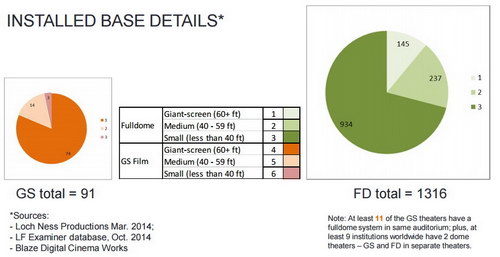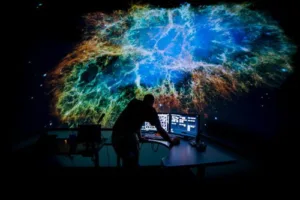On February 25 through March 1, 2015, IMERSA held its 6th annual Summit in Denver Colorado. IMERSA’s tag line is “Advancing the art and technology of immersive digital experiences” and its mission is to advance and promote the art and science of large-scale digital immersive media, fulldome, and immersive group experiences in digital planetariums, mobile domes, themed entertainment and giant screen theaters.
Total 2015 IMERSA summit attendance was 225, with most of the delegates attending Thursday through Saturday. Next year’s summit is scheduled for March 3 – 6, 2016.

Installed base details for giant screen and fulldome theaters presented by Paul Fraser at the IMERSA Summit.
Paul Fraser of Blaze Digital Cinema Works LLC gave a presentation at the Summit titled “Theater Business Models: Planetariums vs. Giant Screen Theaters”. According to his data, there are 1,316 fulldome theaters and 91 giant screen theaters in the world, with some overlap. The bulk of these fulldome theaters (AKA Planetariums) are in the US, Western Europe, Korea and Japan, with others scattered around the world. While these numbers are small relative to the numbers of conventional cinema screens, they are enough to support a vibrant ecosystem, including both technology and content. IMERSA estimates that there are 290 fulldome titles currently in distribution with 86 fulldome producers to generate new content. IMERSA has about 45 sponsors of both the Summit and the organization in general. In addition to dome projection, head-mounted VR systems were a very hot topic at the Summit. And, of course, they were much easier to demonstrate than large dome projection systems.
One of IMERSA’s sponsors, Digital Projection, did show its laser projector in a portable dome at the summit. Barco (formerly projectiondesign), while not a sponsor, was there showing off the new F50 projector, successor to the F35, on a flat screen.
Some of the 200 attendees at the IMERSA Summit 3 hour Pro.Show demonstration session in front of the inflatable dome used by Digital Projection. Photo Credit: IMERSA
One of the issues of fulldome projection is the resolution of the image. Late last year (October 22, 2014), the Giant Screen Cinema Association (GSCA) hosted a Digital Dome Day at The Dome, the giant screen dome theater at the Science Museum of Virginia. This was a shoot-out between the reining technology of large dome projection, 15 perforation, 70mm film (1570 film) and digital projection that approximated an 8K image. The digital side used five Christie 4K projectors running at 25,000 lumens each and 120Hz, producing 4Ft Lamberts on the 23M dome. While true 8K projection nominally has 50Mpixels, due to overlap between the projectors filling the dome, this demo had ‘only’ 23Mpixels. IMERSA did not ignore 8K content either. They had a special demo of 8K content on the fulldome at the Fiske Planetarium in Boulder, Colorado on the last evening of the Summit.
Justin Bartel at Science Museum of Virginia, Photo Credit: Sean Dewitt Photography
The GSCA demo in Virginia was a true side-by-side comparison with half of the dome filled with the digital projection and half by the film projection. On the film side, experts saw typical film problems such as dust, film fading and scratches. In addition, they saw judder and weave that they hadn’t noticed before, compared to the rock-steady digital projection. On the other hand, the 1570 film had somewhat higher resolution. Viewers at the demo said the digital and film images were comparable in terms of brightness and contrast. The ability to distort the image to eliminate artifacts by the film projector’s fish-eye lens was also appreciated. So for now, film vs digital is a toss-up: higher resolution vs better image quality.
Lumens are so critical because fulldome theaters are big. The 23M (75 feet) diameter dome at the University of Virginia has about 831M2 (8945 square feet) of screen surface. This is the same area as a 43M x 19M (142’ x 63’) flat screen. If the 4ft-lamberts achieved turns out to not be enough, or someone wants a bigger dome than the 23M dome in Virginia, 25,000 lumens per projector is not the upper limit: lamp-based 4K projectors can produce up to about 40,000 lumens and laser-based 4K projectors can produce up to 100,000 lumens or more.
Can full-dome theaters afford five (or more) $250K (or more) laser projectors? Surprisingly, the answer may be yes. A number of years ago, I looked into the economics of fulldome theaters vs cinema and found, even at the time, large domes could afford very expensive projectors, $1M or more. Most of these domes are at museums or universities where large donors or grants will pay to buy the projector. However, nobody wants to pay for five new xenon lamps every week or so. The high up-front costs and low maintenance costs of laser projectors are a good match for this economic reality.
Analyst Comment
So who’s going to be the first to install a set of five 4K laser projectors in their planetarium? We’ll see, but I predict it will happen within the next couple of years. – Matthew Brennesholtz

